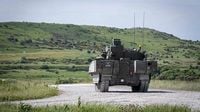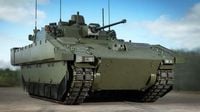On the muddy training grounds of Salisbury Plain, the British Army’s most ambitious armoured vehicle project in decades has hit yet another roadblock. Just weeks after the Ministry of Defence (MoD) declared the Ajax fleet ready for action, the Army has again suspended all use of the vehicles following a spate of troubling health incidents among crew members. The pause, announced on 26 November 2025, is the latest chapter in a saga that has seen the Ajax programme lauded for its technological promise but dogged by persistent technical woes.
The latest crisis unfolded during a training exercise earlier in November, when about 30 soldiers operating Ajax vehicles began experiencing worrying symptoms attributed to excessive noise and vibration. According to BBC News, some emerged from the vehicles vomiting, while others were physically shaking—so much so that they struggled to control their bodies. The exercise was immediately halted, and all affected personnel were given medical care. Most have since been cleared for duty, but a handful remain under expert medical supervision.
"As safety is my top priority, prior to IOC I asked for and was given assurances in writing by senior Ministry of Defence personnel that the system was safe. On 22 November 2025 around 30 service personnel operating Ajax reported noise and vibration symptoms during a training exercise. The exercise was stopped immediately in line with our safety protocols and those affected received full medical care and attention, and continue to be monitored. There have not been any hospitalisations and none of the symptoms are life threatening," Defence Readiness & Industry Minister Luke Pollard stated in a written address to the House of Commons, as reported by ESD Magazine.
The decision to pause all training and exercises with Ajax is not the first for the troubled programme. Since its inception, Ajax has faced repeated delays, technical problems, and cost overruns—most notably related to the same noise and vibration issues that resurfaced this month. The MoD confirmed that, while a full safety investigation is underway, a limited amount of technical testing will continue in hopes of finally pinpointing the root cause and implementing lasting fixes.
For the British Army, the Ajax fleet represents a bold leap into the future. Designed to replace the aging CVR(T) vehicles that first entered service in 1971, Ajax was billed as the most technologically advanced medium-weight armoured fighting vehicle in the world. The family of six tracked variants—Ajax, Ares, Athena, Argus, Atlas, and Apollo—boasts features like digitally networked battlefield sensors, a 40mm CT40 cannon capable of firing on the move, modular armour, and advanced suspension. These vehicles are intended to serve at the heart of the Army’s 3rd Deep Strike Reconnaissance Strike Brigade, gathering intelligence, coordinating artillery, and supporting engineering and logistics operations.
The Ajax programme’s scope is as ambitious as its technology. In September 2014, the MoD ordered 589 vehicles from General Dynamics UK under a contract worth £5.522 billion (EUR 6.28 billion), with production centered in Merthyr Tydfil, Wales. More than 160 vehicles had been delivered by early November 2025, and the programme was declared to have reached Initial Operating Capability (IOC) on 6 November. That milestone was marked by a note of optimism from Defence Minister Pollard, who described Ajax as "the most advanced medium-weight armoured fighting vehicle on the planet" and claimed, "We have more than a full squadron ready to go, ready to fight, ready to win, with more in the pipeline."
Yet, the celebrations were short-lived. Just days after the IOC announcement, news broke that three members of the Household Cavalry Regiment faced medical discharge due to injuries sustained since Ajax’s introduction. The MoD later confirmed that 31 personnel showed symptoms following Exercise ‘Titan Storm’, and that about 30 soldiers reported issues during the subsequent training exercise that triggered the latest pause. According to a Ministry of Defence spokesperson cited by Army Technology, "the vast majority of these have now been medically cleared and are continuing on duty. A small number of personnel continue to receive expert medical care."
The recurring nature of these issues has drawn sharp criticism and concern. The Ajax fleet was originally expected to enter service in 2017, but delays caused by technical failures—especially those linked to noise and vibration—pushed operational readiness to late 2025. A 2023 review of the £6.3 billion programme highlighted "systemic, cultural and institutional problems" at the MoD, as well as "a number of errors of judgement" in the project’s oversight, according to BBC News. The House of Commons Public Accounts Committee was even blunter in a June 2022 report, stating that the Ajax programme had "gone badly wrong, with no deployable vehicle delivered to date."
Some of the deepest problems, as reported by ESD Magazine, stemmed from the quality of the ASCOD-based platforms delivered from Spain, repeated changes to vehicle requirements within the MoD, and a reluctance from General Dynamics management to fully acknowledge and address the issues. While then-Defence Secretary Ben Wallace declared in February 2023 that "we think the remedies are in place, we are now going through the normal trials. … I am confident we have turned the corner on this troubled programme," the events of November 2025 suggest that the corner may not yet be fully rounded.
For the Army’s operational planners, the implications are serious. Defence analyst Callum Kaye told Army Technology that Ajax is "of critical importance" to British Army doctrine, underpinning the reconnaissance and precision strike capabilities of the 3rd Division. Ongoing operational problems, he warned, could "inhibit the accuracy of precision fires missions carried out by the brigade’s M270s and significantly reduce the combat effectiveness of the armoured brigades." Previous attempts to mitigate the issues—such as advising crew to wear double ear protection—have proven insufficient.
The Ajax fleet’s technological promise remains undeniable. Its advanced digital ecosystem, modular design, and integrated battlefield systems could transform how the British Army gathers and acts on intelligence. The MoD continues to tout Ajax as a "world-class" system with significant export potential, especially if its safety issues can be resolved. The programme has also been a boon for the UK defence industry, involving more than 230 supplier companies and supporting over 4,100 jobs.
Still, as the Army pauses Ajax training once more, questions linger. How could a vehicle declared safe for service continue to pose health risks? Can the MoD and General Dynamics finally deliver on the fleet’s promise without endangering the soldiers it is meant to protect? For now, the answer remains elusive, and the British Army’s most modern armoured vehicle faces its toughest test not on the battlefield, but in the workshop and the hospital ward.
The Ajax story is, in many ways, a microcosm of the challenges facing modern military procurement: high expectations, technological complexity, and the ever-present need to balance innovation with the safety and wellbeing of those on the front lines. Until the investigation concludes and effective solutions are found, Ajax’s future will remain as uncertain as ever for the troops who depend on it.






